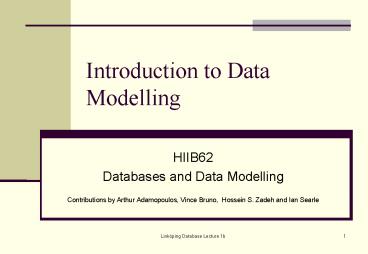Introduction to Data Modelling - PowerPoint PPT Presentation
1 / 31
Title:
Introduction to Data Modelling
Description:
Contributions by Arthur Adamopoulos, Vince Bruno, Hossein S. ... Chapter 3, 4, database modelling (important) Models. A model in general is an ... 'crow's feet' ... – PowerPoint PPT presentation
Number of Views:37
Avg rating:3.0/5.0
Title: Introduction to Data Modelling
1
Introduction to Data Modelling
- HIIB62
- Databases and Data Modelling
- Contributions by Arthur Adamopoulos, Vince Bruno,
Hossein S. Zadeh and Ian Searle
2
Data Modelling
- E-R Diagrams
- Relational Model
- Reference
- MFP
- Chapter 2, general information
- Chapter 3, 4, database modelling (important)
3
Models
- A model in general is an abstract of reality.
- Models can be expressed in different ways using
different tools. - Target different audiences
- Getting a better overall view of a real life
application - In databases, we can model an actual database
and/or reality.
4
Entity Relationship Diagrams
- Most popular model currently used for database
modelling - Designed to be platform independent
- Primary components
- Entities
- Relationships
- Attributes
5
ENTITY
- Object or Event. Real or Imaginary
- Interesting enough to us that we want to record
something about it - Entity drawn as a box and a name
- Represents a collection of individual objects
that we can uniquely identify from each other. - Objects are called entity instances
6
ENTITY
STUDENT
- This box is the Entity STUDENT
- The entity actually represents the collection of
individual students
7
ATTRIBUTE
- A property or characteristic of an entity
- A piece of data that we want to keep about the
entity. - Drawn as an ellipse connected to the entity.
8
Types of Attributes
- The primary key attribute is underlined.
- A multi-valued attribute is an attribute that can
have several values. It is shown in a double
ellipse.
9
RELATIONSHIP
- Some type of association between entities
- Shown as a line (sometimes with a diamond)
joining entities together with a relationship
name. - The actual associations are between the
individual objects in the entities. - Therefore, the Relationship represents the
collection of individual associations.
10
RELATIONSHIP
Enrol
STUDENT
COURSE
- This diamond represents the collection of
individual associations between individual
students and courses
COURSE
11
DEGREE
- Number of Entities a relationship is involved in
- Binary (two) - most common
12
DEGREE (Unary)
- A Unary relationship is a relationship of an
entity to itself. - The associations are between different objects of
the same entity.
13
DEGREE (Ternary n-ary)
- Ternary is between 3 entities
- We can actually have a relationship between any
number of entities.
14
Cardinality
- Determines how many associations are allowed
between individual objects involved within a
relationship. - Shown using crows feet or with 1M
- Enables us to constrain the relationships to only
allow particular situations (how many courses can
a student have?)
15
Cardinality (One to Many)
- A student can only have one course
- A course can have many students
16
Cardinality (One to One)
- A student can only have 1 library card
- A library card can only be for 1 student
17
Cardinality (Many to Many)
- A student can have many subjects
- A subject can have many students
18
Relationships
- Relationships can also have attributes
- There is no clear rule to determine between a
relationship and an entity - Often, an entity can become a relationship and a
relationship can be re-drawn as an entity.
19
RELATIONAL MODEL
- A model of files (also referred to as tables) and
fields - (lower level than E-R)
- Fields cannot be multi-valued
- A Primary key is the unique identifier of the
file, and can be 1 or more fields. - A Foreign key is a field that is a primary key in
another file.
20
Relational Model
21
Mapping E-R and Relational
- Both models model the same thing, a database
structure (existing or future) - One model can be re-drawn to the other
E-R
RELATIONAL
ENTITY ATTRIBUTE
TABLE FIELD
22
Mapping - Relationships
- Relationships in the E-R model are represented by
Foreign Keys in the relational model - Foreign keys are NOT attributes in the E-R model,
they represent the relationship diamond. - One more time, foreign keys are NOT E-R
attributes!
23
Mapping - 11 Relationship
- Put the foreign key on either side
24
Mapping - 1M Relationship
- Put the foreign key on the Many side
25
Mapping - MN Relationship
- Create a new file/table to represent the
relationship - Primary keys of both sides are combined to make
the primary key of the new file.
26
Mapping - MN Relationship
NOTE Gerund is halfway between a relationship
and an entity.
27
Components - summary
28
Components - summary
Enrol
STUDENT
SUBJECT
belong
COURSE
29
Alternative Notation (Visio)
30
Advantages
- Good quality diagrams
- Variety of formats supported
- Automatically adds primary and foreign keys
(combination of ERD and Relational Model) - Identifying, non identifying
- Can be used to generate the database
- Notation for unary and subtypes
31
Gary Solution































